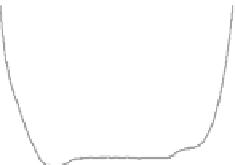Environmental Engineering Reference
In-Depth Information
Fig. 7.43 a Stack voltage
and current acquisition versus
time during the dynamic cycle
characterized by the maxi-
mum stack current variation
of 10 A/s. Air management
strategy N.4. b Stoichiometric
ratio and air flow rate acqui-
sition versus time for the
experiment (a). c Stack tem-
perature (measured at the
outlet of cathode side), water
temperature (measured in the
cooling circuit at the outlet of
the stack), inlet air relative
humidity and temperature
acquisition versus time for the
experiment (a)
a
80
250
Stack Current
Stack Voltage
75
200
70
150
65
60
100
55
50
50
45
0
0
10
20
30
40
50
60
Time [s]
b
30
5
28
4.5
26
4
24
3.5
22
3
20
2.5
18
2
16
1.5
14
1
Stoichiometric Ratio
Air Flow Rate
12
0.5
10
0
0
10
20
30
40
50
60
Time [s]
c
330
100
325
99
320
315
98
310
97
305
Humidity
Air Temp. OUT Stack
Air Temp. IN Stack
H2O Temp
300
96
295
290
95
0
10
20
30
40
50
Time [s]
tests of Figs.
7.42
,
7.43
, and
7.44
are reported versus cycle length in Fig.
7.45
,
where the differences between the C
v
values for the three current ramps (2, 10, and
25 A/s) are evidenced. While at 2 and 10 A/s the C
v
profiles show a regular
behavior associated with stack power values rather than dynamic ramps, at 25 A/s
a strong effect of dynamic requirements is observed on C
v
, as this coefficient
reaches almost 3.5 at the end of the acceleration step.













































































































































































































































































































































